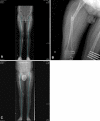Is bilateral lower limb lengthening appropriate for achondroplasia?: midterm analysis of the complications and quality of life
- PMID: 21785895
- PMCID: PMC3254769
- DOI: 10.1007/s11999-011-1983-y
Is bilateral lower limb lengthening appropriate for achondroplasia?: midterm analysis of the complications and quality of life
Abstract
Background: Use of the Ilizarov technique for limb lengthening in patients with achondroplasia is controversial, with a high risk of complications balancing cosmetic gains. Although several articles have described the complications of this procedure and satisfaction of patients after surgery, it remains unclear whether lengthening improves the quality of life (QOL) of these patients.
Questions/purposes: We asked whether bilateral lower limb lengthenings with deformity correction in patients with achondroplasia would improve QOL and investigated the correlation between complication rate and QOL.
Patients and methods: We retrospectively reviewed 22 patients (average age, 12.7 years) diagnosed with achondroplasia who underwent bilateral lower limb lengthenings between 2002 and 2005. These patients were compared with 22 patients with achondroplasia for whom limb lengthening was not performed. The two groups were assessed using the American Academy of Orthopaedic Surgeons (AAOS) lower limb, SF-36, and Rosenberg self-esteem scores. Minimum followup was 4.5 years (range, 4.5-6.9 years).
Results: Among the lengthening group, the average gain in length was 10.21 ± 2.39 cm for the femur and 9.13 ± 2.12 cm for the tibia. A total of 123 complications occurred in these 88 segments. The surgical group had higher Rosenberg self-esteem scores than the nonsurgical group although there were no differences in the AAOS and the SF-36 scores. The self-esteem scores decreased with the increase in the number of complications.
Conclusions: Our data suggest that despite frequent complications, bilateral lower limb lengthening increases patients' QOL. We believe lengthening is a reasonable option in selected patients.
Level of evidence: Level IV, therapeutic study. See the Guidelines for Authors for a complete description of levels of evidence.
Figures

References
-
- Adelson BM. The Lives of Dwarves: Their Journey From Public Curiosity Toward Social Liberation. New Brunswick, NJ: Rutgers University Press; 2005.
-
- Aldegheri R, Trivella G, Renzi-Brivio L, Tessari G, Agostini S, Lavini F. Lengthening of the lower limbs in achondroplastic patients: a comparative study of four techniques. J Bone Joint Surg Br. 1988;70:69–73. - PubMed
Publication types
MeSH terms
LinkOut - more resources
Full Text Sources
Medical
Research Materials

